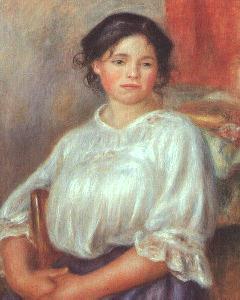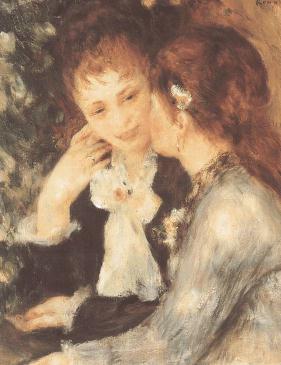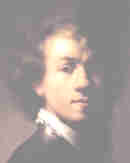^
Died on 22 December 1915: Arthur Hughes,
English Pre-Raphaelite
painter and illustrator born on 27 January 1832.
— He studied under Alfred Stevens. In about 1850 he converted to Pre-Raphaelitism.
Met Holman Hunt, Rossetti, Madox Brown, and later Millais. In 1852 he exhibited
his first major Pre-Raphaelite picture Ophelia. Throughout the 1850s
and 1860s Hughes continued to produce a series of delicately poetic pictures,
which hover on the knife-edge between sentiment and sentimentality but are
always redeemed by their brilliant color and microscopic detail. Some of
the best known are Home from the Sea, The Long Engagement, Aurora Leigh's
Dismissal of Romney and April Love which Ruskin thought "exquisite
in every way". In 1857 he worked with other Pre-Raphaelites on the frescoes
in the Oxford Union. About 1858, Hughes retired to live with his family
in the suburbs of London. He lived at 284 London Rd, Wallington, Sutton,
and at Eastside House, 22 Kew Green, Richmond. Hughes being of a quiet and
retiring nature, very little is known of his later career. After about 1870
his work lost its impetus. Hughes was the original illustrator of Tom
Brown's Schooldays, and George MacDonald's At the Back of the North
Wind and The Princess and the Goblin. He also illustrated Allingham's
Music Master and many other novels, children's books and periodicals.
He worked with Christina Rossetti on Sing Song in 1871. A sale of his works
took place at Christie's after his death on 21 November 1921.
— Hughes showed early artistic promise and enrolled in the Royal Academy
Antique School in 1847. He was encouraged by Millais, who was always an
affable individual. Hughes was inspired directly by The Germ, the short-lived
Pre-Raphaelite magazine. He attended PRB meetings, in rather a junior hero-worshipping
manner. Hughes was liked by the PRB, in fact he was throughout his long
life, a well liked individual. He was also encouraged by Rossetti.
Hughes main traits as an individual were
his modesty and self-effacement. He suffered somewhat at the hands of the
Royal Academy, having a number of ill-merited rejections, and very badly
hung pictures. He was never even elected an Associate. Hughes married, in
1855 Tryphena Foord, the union was lasting, and happy. As well as the limits
imposed by his diffidence and modesty, Hughes was motivated by the desire
for a stable, happy family life. Ultimately he was prepared to compromise
artistic ambitions for this.
Many of his pictures were of ordinary scenes
of life. They were painted with great delicacy, and feeling, and were often
in greens and mauves. Like the great orchestral composers, the warm sympathetic
character of the man shines through in his work. William Michael Rossetti,
writing about Hughes said “If I had to pick out, from my once numerous acquaintances
of the male sex, the sweetest and most ingenuous nature of all, the least
carking and querulous, and the freest from envy hatred and malice, and all
uncharitableness, I should probably find myself bound to select Mr. Hughes.”
Should any human being have a better character reference, or epitaph than
this I have yet to see it.
Following the death of Tryphena Hughes in
1921, their daughter Emily had to move to a smaller house. There was, therefore,
a shortage of space. As a result she had her father’s remaining preparatory
sketches, and all his private papers and correspondence destroyed.
— Drawing
portrait by the artist's son, Arthur Foord Hughes.
— Photo
of Hughes
— LINKS
— Self-Portrait
(1851)
— The
Annunciation (1858, 61x36cm) — The
Nativity (1858, 61x37cm)
— The
Long Engagement (1859, 105x52cm) — The
Mower (1865)
— The
Property Room (1879) — Asleep
in the Woods
— Old
Neighbour Gone Bye — The
Brave Geraint (1860, 23x36cm)
— The
Eve of Saint Agnes (1856, 64x57cm) — Overthrowing
of the Rusty Knight
— The
Knight Of The Sun.
— Ophelia
(1853; 68x124cm; framed 590x1000pix, 166kb) _ The writing outside the side
arcs of this semicircular painting reads:
There is a willow grows ascaunt the brook, That shows his hoar leaves in
the glassy stream; There with fantastic garlands did she come. Of crow-flowers,
nettles, daisies, and
long purples. There on the pendant boughs her coronet weeds Clambering to
hang an envious sliver broke. When down the weedy trophies and herself Fell
in the weeping brook.
— Home
From the Sea (1857, 51x65cm; 723x950pix, 231kb) _ A young sailor boy
has come back from the sea to find that his mother has died. With his sister
he is mourning at her grave. Hughes began the picture in 1856, in the old
churchyard at Chingford in Essex. At first the picture contained only the
figure of the boy, and was entitled A Mother's Grave; later the sister
was added, and the title was changed. The model for the boy may have been
Hughes' nephew, Edward Robert Hughes.
— Knight
of the Sun (1861, 22x32cm) _ An aged warrior mortally wounded, being
carried by his men-at-arms to the shelter of a religious house.
— La
Belle Dame Sans Merci (1863, 152x122cm) _ This painting is based on
the poem La
Belle Dame Sans Merci by John Keats [31 Oct 1795 – 23 Feb
1821]
_ See other paintings on the same subject:
_ La
Belle Dame Sans Merci (1926; 604x594pix, 56kb) by Cowper
_ La
Belle Dame Sans Merci (1865, 46x56cm; 1249x1500pix, 141kb) by Crane
[15 Aug 1845 – 15 Mar 1915]
_ La
Belle Dame Sans Merci (1926; 422x596pix, 71kb) by Dicksee
_ La
Belle Dame Sans Merci (1893; 800x580pix, 107kb) by Waterhouse
— A
Music Party (1864) _ When exhibited at the Royal Academy in 1864, the
accompanying lines from John Keats' Ode on a Grecian Urn were included
in the catalogue: 'Heard melodies are sweet, but those unheard are sweeter
Not to the sensual ear, but more endear'd Pipe to the spirit ditties of
no tone.'
— Good
Night (1866, 99x65cm) _ 'Day's turn is over: now arrives the Night's.'
from Robert Browning, Pippa Passes.
— Sir
Galahad (1869, 113x168cm) _ Inscribed on the back: 'The clouds are broken
in the sky, And thro' the mountain-walls, A rolling organ-harmony Swells
up, and shakes and falls, Then move the trees, the copses nod, Wings flutter,
voices hover clear: Oh just and faithful knight of God! Ride on: the prize
is near. So pass I hostel, hall, and grange; By bridge and ford, by park
and pale, All-arm'd I ride, whate'er betide, Until I find the holy Grail'.
.... A gentle sound, an awful sight! Three angels bear the holy grail: With
folded feet, in stoles of white, On sleeping wings they sail.' |

 ^
2000 One Rembrandt and 2 Renoirs stolen.
^
2000 One Rembrandt and 2 Renoirs stolen. [< the
one shown here is safe at the Mauritshuis in The Hague] and two works
by the French impressionist Pierre-Auguste
Renoir — A Young Parisian Woman and Conversation [not those
shown here: Young Women talking 1878 >, and < Young
Girl Seated 1909].
[< the
one shown here is safe at the Mauritshuis in The Hague] and two works
by the French impressionist Pierre-Auguste
Renoir — A Young Parisian Woman and Conversation [not those
shown here: Young Women talking 1878 >, and < Young
Girl Seated 1909]. .jpg)
.jpg)
.jpg)
.jpg)
.jpg)
.jpg)